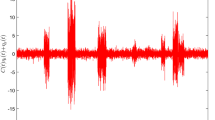Abstract
In this paper, an accurate framework is proposed for deriving the closed-form expression for the average symbol error probability (ASEP) of generalized M-ary quadrature amplitude modulation (M-QAM) over the Beaulieu-Xie fading channel. This fading channel is extremely useful for characterizing heterogeneous networks, femtocells, and also for modeling of fading channel for high speed trains due to its ability to combine the properties of both Nakagami-m and Rician fading models. Due to efficient bandwidth and high data rate, the M-QAM modulation scheme is utilized for the 4G LTE, 5G network, etc. The closed-form expression for the ASEP of generalized M-QAM in terms of Gauss hypergeometric function is derived in this work. The advantage of this expression is that along with M-QAM, we can evaluate ASEP of many other modulation schemes such as binary phase shift keying (BPSK), quadrature phase shift keying (QPSK), etc. The numerical results are presented for the exact closed-form solution, which are a close match with Monte-Carlo simulations. To achieve ASEP of 10−3, 64-QAM requires 4.79 dB more average SNR as compared to 16-QAM for the case of m = 2, K = 1.




Similar content being viewed by others
References
Mirahmadi, M., Dweik, A. A., & Shami, A. (2014). Interference modeling and performance evaluation of heterogeneous cellular networks. IEEE Transactions on Communications, 62(2), 2132–2144.
Singh, S., & Kansal, V. (2015). Performance of M-ary PSK over TWDP fading channels. International Journal of Electronics Letters, 4(4), 433–437.
Beaulieu, N. C., & Jiandong, X. (2015). A novel fading model for channels with multiple dominant specular components. IEEE Wireless Communication Letters, 4(1), 54–57.
Olutayo, A., Cheng, J., & Holzman, J. F. (2020). Performance bounds for diversity receptions over a new fading model with arbitrary branch correlation. EURASIP Journal on Wireless Communications and Networking., 97, 1–26.
Guan, K., Zhong, D., Ai, B., & Kuerner, T. (2014). Propagation measurements and analysis for train stations of high-speed railway at 930 MHz. IEEE Transactions on Vehicular Technology, 63(8), 3499–3516.
Dixit, D., & Sahu, P. R. (2013). Performance of QAM signaling over TWDP fading channels. IEEE Transactions on Wireless Communications, 12(4), 1794–1799.
Sadhwani, D., & Yadav, R. N. (2017). A simplified exact expression of SEP for cross QAM in AWGN channel from M×N rectangular QAM and its usefulness in Nakagami-m fading channel.AEU. International Journal of Electronics & Communications, 74, 63–74.
Kapucu, N. (2019). Error performance of digital modulations over Fischer-Snedecor F fading channel. AEU International Journal of Electronics & Communications, 108, 73–78.
Olutayo, A., Ma, H., Cheng, J., & Holzman, J. F. (2017). Level crossing rate and average fade duration for the Beaulieu-Xie fading model. IEEE Wireless Communications Letters, 6(3), 326–329.
Olutayo, A., Cheng, J., &Holzman, J. F. (2017). Asymptotically tight performance bounds for selection diversity over Beaulieu-Xie fading channels with arbitrary correlation. In IEEE International Conference on Communication (ICC) (pp. 1–6).
Olutayo, A., Cheng, J., &Holzman, J. F. (2017). Asymptotically tight performance bounds for equal-gain combining over a new correlated fading channel. In 15th Canadian workshop on information theory (CWIT) (pp. 1–5).
Kansal, V., & Singh, S. (2017). Analysis of effective capacity over Beaulieu-Xie fading model. In IEEE international women in engineering conference on electrical & computer engineering, Dehradun, India (pp. 207–210).
Kansal, V., & Singh, S. (2019). Analysis of binary PSK modulations over the line-of-sight plus scatter fading model. In: Data and communication networks. advances in intelligent systems and computing (Vol. 847, pp. 13–20). Springer.
Kansal, V., & Singh, S. (2018). Analysis of average symbol error probability of MDPSK MFSK and MPSK in the Beaulieu-Xie Fading. In: 6th edition of IEEE international conference on wireless networks & embedded systems (WECON) (pp. 11–14).
Hu, J., Zhang, Z., Dang, J., Wu, L., & Zu, G. (2019). Performance of decode-and-forward relaying in mixed Beaulieu-Xie and M- dual hop transmission systems withdigital coherent detection. IEEEAccess, 7, 138757–138770.
Chauhan, P. S., Kumar, S., & Soni, S. K. (2020). On the physical layer security over Beaulieu-Xiefading channel. International Journal of Electronics and Communications, 113, 1–7.
Kansal, V., & Singh, S. (2020). Capacity analysis of maximal ratio combining over Beaulieu-Xie fading. Annals of Telecommunications, 76, 43–50.
Gradshteyn, I. S., & Ryzhik, I. M. (2000). Table of integrals, series and products (5th ed.). Academic Press.
Simon, M. K., & Alouini, M. S. (2005). Digital communication over fading channels (2nd ed.). Wiley.
Seo, S., Lee, C., & Kang, S. (2004). Exact performance analysis of M-ary QAM with MRC diversity in Rician fading channels. Electronic Letters, 40(8), 485–486.
Abramowitz, M., & Stegun, I. A. (1972). Handbook of mathematical functions with formulas, graphs, and mathematical tables (9th ed.). Dover.
Brychkova, Yu. A., & Saad, N. (2014). On some formulas for the Appellfunction. Integral Transforms and Special Functions, 25(2), 111–123.
Acknowledgment
This work is supported by Visvesvaraya Ph.D. Scheme for Electronics & IT, MeitY, Govt. of India under grant no. VISPHD-MEITY-1674.
Author information
Authors and Affiliations
Corresponding author
Additional information
Publisher's Note
Springer Nature remains neutral with regard to jurisdictional claims in published maps and institutional affiliations.
Rights and permissions
About this article
Cite this article
Kansal, V., Singh, S. Error performance of generalized M-ary QAM over the Beaulieu-Xie fading. Telecommun Syst 78, 163–168 (2021). https://doi.org/10.1007/s11235-021-00775-0
Accepted:
Published:
Issue Date:
DOI: https://doi.org/10.1007/s11235-021-00775-0




